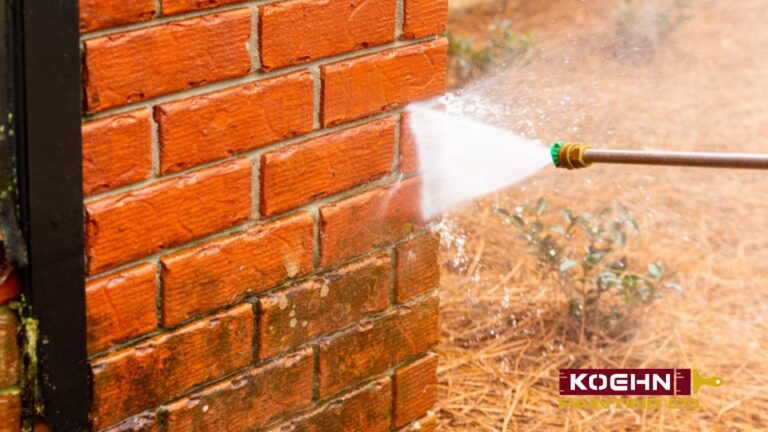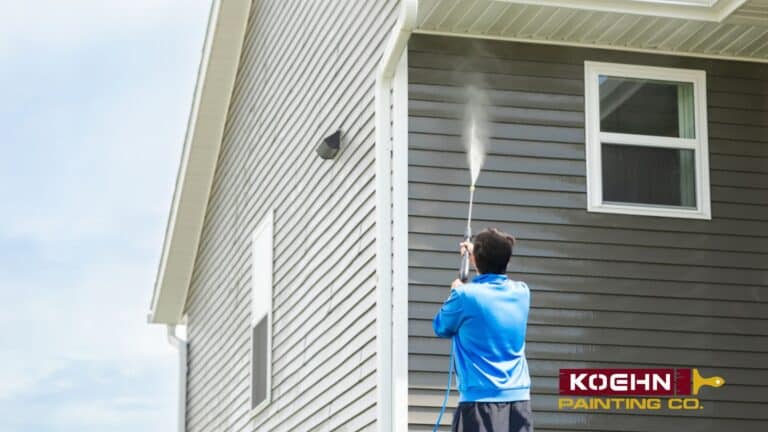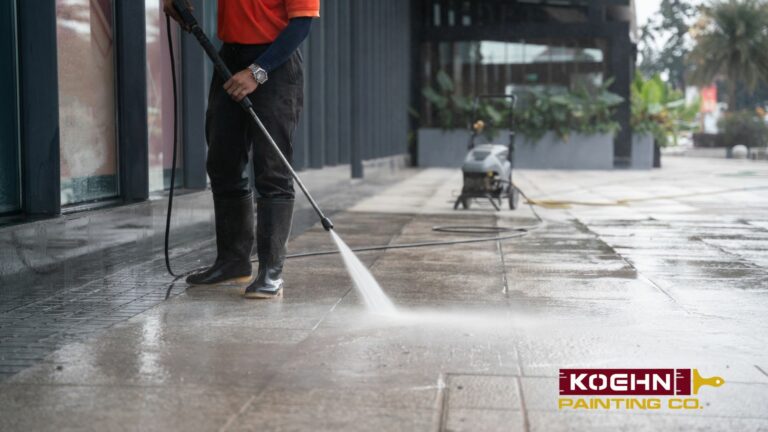What Is the Average Cost for Pressure Washing
The average cost for pressure washing is a small price to pay for the benefits it offers. A clean exterior does more than improve appearance—it directly influences property value, safety, and long-term durability.
Pressure washing removes dirt, algae, and mildew that can damage surfaces, extends the life of siding, wood, and concrete, and makes walkways safer by removing slippery buildup. For homeowners preparing to sell, a fresh wash enhances curb appeal and can even increase perceived property value by up to 5%.
Think of it as a cost-effective upgrade that protects your investment while making your home look brighter and more welcoming.
When it comes to cleaning methods, understanding the difference between pressure washing and power washing is important. Pressure washing uses cold, high-pressure water, making it perfect for routine cleaning tasks like siding, decks, patios, and driveways.
Power washing, on the other hand, uses heated water to break down grease, oil, salt, and tough stains — ideal for commercial or heavy-duty projects. Because of the extra equipment and energy, power washing usually costs $50–$150 more per job.
On average, homeowners spend about $310 on pressure washing, while power washing of similar scope usually costs between $400 and over $600. Choosing the right method ensures you pay only for what your property actually needs without overspending.
The cost of pressure washing depends on several factors, including square footage, surface type, and pricing methods. Professionals may charge by square foot ($0.10–$0.50), flat rate ($100–$300 for driveways, patios, or fences), or hourly ($50–$100 per hour).
National averages from Angi, HomeAdvisor, and Thumbtack show most projects range between $212 and $447, with larger homes costing $1,400 or more. Timing also matters—spring and summer tend to have higher demand and prices, while off-season bookings might offer discounts.
While DIY pressure washing is an option, renting or buying equipment involves risks like property damage or injury. Professional services offer expertise, insurance, and better results.
Ultimately, pressure washing is a small investment compared to the benefits it provides. Spending a few hundred dollars can refresh your home’s look, prevent long-term damage, and increase your property’s safety and value. Let’s explore this topic in detail in the next sections.
Why Clean Exteriors Matter More Than You Think
Imagine two homes side by side: one has a dull, algae-stained facade with a grimy driveway, while the other looks crisp, bright, and well-cared-for. Without hesitation, your eyes are drawn to the latter. That first impression matters more than just aesthetics; view it as a sign of attention, value, and reliability. That’s the power of a clean exterior.
Cleaning your exterior using power washing can bring many benefits, such as:
- Instant curb appeal that stands out: A well-maintained exterior speaks volumes before anyone even steps inside. Dirt, mildew, algae, and grime diminish your home’s appearance and perceived value. A thorough pressure wash removes all of that, restoring colors, textures, and confidence. It’s essentially a facelift for your house in just a few hours. Pressure washing can even boost perceived property value by up to 5%, especially during a sale.
- Armor against long-term damage: Exterior grime isn’t just cosmetic. It’s organic warfare. Mold, moss, and mildew degrade surfaces, erode sealants and finishes, and can lead to premature decay. Regular pressure washing flushes out the buildup before it becomes a structural liability, saving you potentially thousands in repairs.
- Extended lifespan (plus, lower maintenance): When surfaces stay clean, they stay tougher. Paint, siding, concrete, and wood all last longer when they’re routinely cleaned. That means fewer replacements, fewer touchups, fewer headaches. And because clean surfaces resist dirt clinging onto them, ongoing maintenance becomes less of a chore and more of a quick sweep. When you keep regular maintenance, the lifespan of the materials can be extended by up to 50%.
- Safety first (and second): A clean walk is a safer walk. Moss, mildew, and slick residue turn decks, patios, and paths into slip hazards. Pressure washing removes those dangers, making your ground-level first impression safer for everyone, from kids to guests.
- Smart pre-sale strategy: If you are selling your property, then pressure washing can set the stage for better listing photos, faster sales, and more substantial negotiating leverage. Clean exteriors reflect more light, making surfaces appear brighter and listing images of a gleaming facade get noticed.
Think of a clean exterior as a strategic home upgrade to boost curb appeal, protect your investment, lower long-term costs, increase safety, and position your house, whether you’re selling soon or just safeguarding its future.
How Power Washing Cost Differs From Standard Pressure Washing
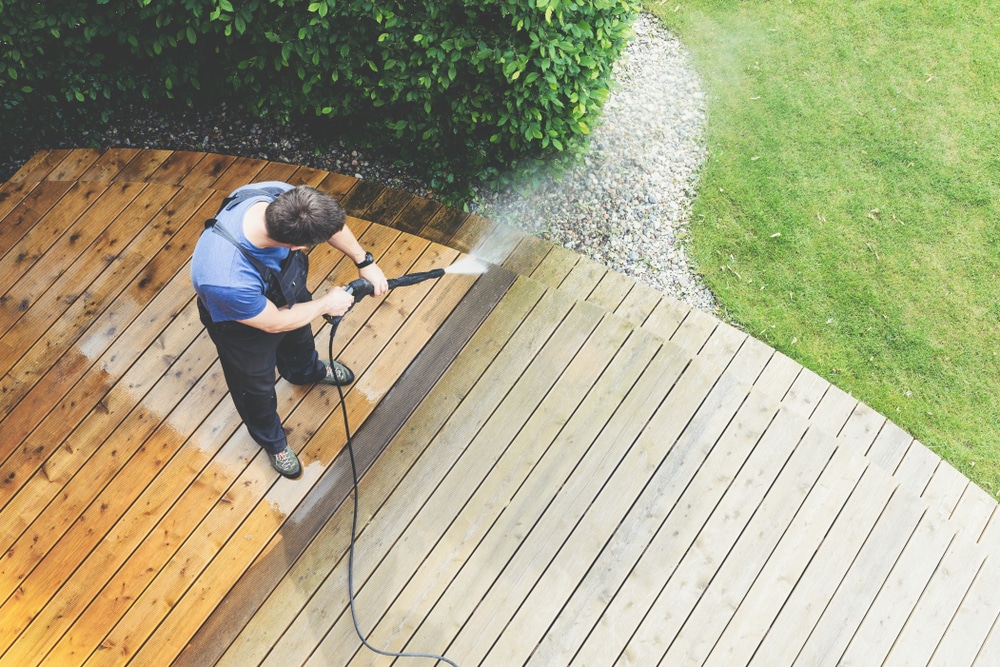
If you’ve ever wondered whether “power washing” and “pressure washing” are just two names for the same service, you’re not alone. Even in the industry, the terms are often used interchangeably. But the difference matters, not only for the results you’ll achieve but also for your budget. Understanding the power washing cost and how it compares to the average pressure washing prices helps you see what you’re paying for and when each service is the best choice.
Pressure washing uses a high-pressure stream of cold water to clean surfaces. It’s great for removing loose dirt, mildew, dust, pollen, and basic grime from siding, patios, decks, fences, and driveways. The main advantage is that cold water under strong pressure is safe for many materials when used correctly.
Power washing, on the other hand, takes things up a notch. It uses the same high-pressure mechanics, but adds heated water, sometimes described as “wet steam.” That heat helps cut through grease, oil, salt residue, and deeply embedded stains that cold water alone might struggle to remove. Think of pressure washing as a garden hose with serious muscle, and power washing as that same hose hooked up to a boiler.
Why the Difference Matters
While the two services may look similar in action, the outcomes and applications differ significantly:
- Pressure washing is best for general exterior cleaning. Driveways with light tire marks, siding with mildew, patios after a rainy season, and fences with algae.
- Power washing is usually reserved for heavy-duty jobs. Oil-stained garage floors, salted winter driveways in colder climates, grease-covered commercial sidewalks, or industrial equipment that’s seen better days.
The heat element means power washing can also sanitize surfaces, which is helpful in commercial or food-service settings. However, it also increases the risk; too much heat combined with high pressure can harm delicate materials like wood siding or painted finishes.
The Cost Factor: Where the Price Gap Appears
Here’s where homeowners really begin to care. Since power washing involves extra equipment, increased energy use, and sometimes specialized training, its cost is usually higher than the average pressure washing price.
Industry data from sources like Angi and Thumbtack consistently show that:
- Pressure washing averages $310 nationwide, with most homeowners paying between $212 and $447 for standard projects. Small jobs like a patio or driveway can fall as low as $100, while larger full-house washes can climb into the $700+ range.
- Power washing usually commands a premium of $50 to $150 more per project compared to pressure washing, depending on the scope and region (Thumbtack). A standard patio pressure wash might cost $150, while a heated power wash of the same patio could edge closer to $250.
In practice, this means you might see:
- Driveway cleaning with pressure washing: $100–$250
- Driveway cleaning with power washing: $150–$400
- Whole-house pressure washing: $310 average, $212–$447 typical range
- Whole-house power washing: often $400–$600+, especially if multiple stories are involved
For most homeowners, pressure washing is their preferred service. It’s more affordable, readily available, and effective for regular upkeep. Annual siding cleaning, seasonal deck refreshes, or a quick curb appeal boost before selling your home are all tasks ideally suited for pressure washing. It’s also the safer choice for fragile surfaces like wood, stucco, or painted exteriors.
But, here’s where many homeowners misstep: opting for power washing when pressure washing would suffice, or vice versa. Pay for power washing when you don’t need it, and you’re overspending. Choose pressure washing for a grease-stained driveway, and you may need multiple sessions or worse, fail to remove the stain entirely. That means wasted money and frustration.
The best approach is to consult a professional who can recommend the right cleaning method for your surfaces. Most reputable experts will be transparent: they’ll suggest standard pressure washing for routine cleaning and reserve power washing for special cases.
When you step back, the difference is clear. Pressure washing meets most everyday cleaning needs, while power washing justifies its higher cost in specific, heavy-duty situations. But knowing which service you need is only part of the story. The other part is understanding how those numbers on an estimate are actually figured out. Square footage, hourly rates, flat fees; professionals use different pricing models, and those models can affect your final bill up or down.
Let’s talk about the mechanics behind pressure washing prices so you know exactly what drives the cost and how to budget smartly.
Contact us here if you would like to find the best painting contractor for your residential or commercial painting needs.
How Pressure Washing Prices Are Calculated
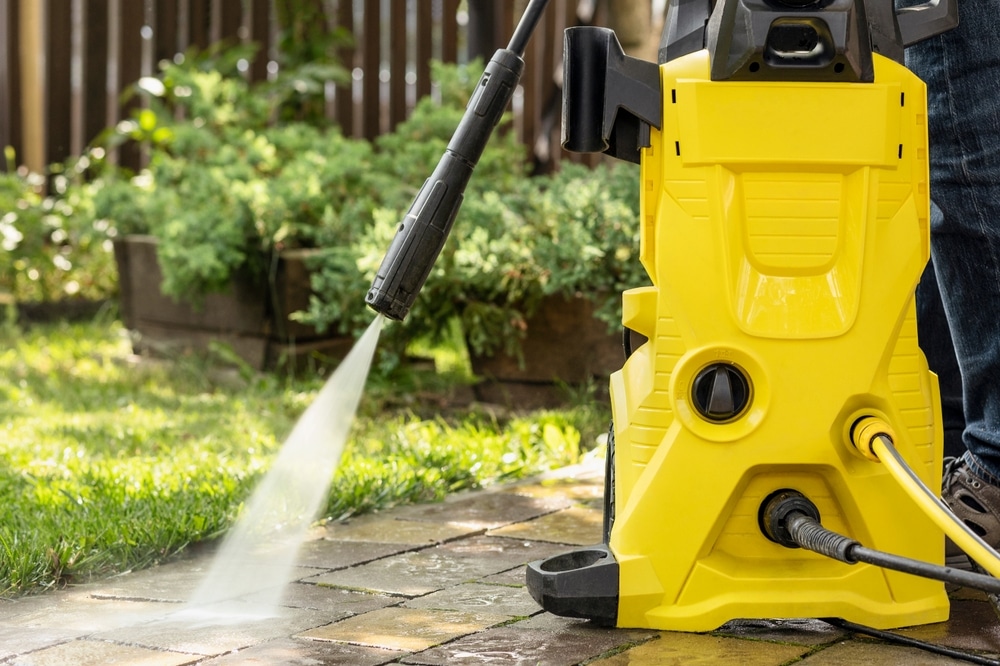
Do you know how to estimate the cost for pressure washing? If not, that’s okay because there is no single answer. While national averages provide a baseline, your final bill depends on how the contractor measures the job, the type of surfaces being cleaned, and even the season. By breaking down the different pricing models, you’ll have a clearer picture of why estimates vary and what’s fair today.
Industry data consistently shows the average cost for pressure washing is around $310 nationwide, with most homeowners paying between $212 and $447 for a standard project. Thumbtack’s report lists a slightly higher national average at $368, with most homeowners spending between $251 and $514 depending on project size and condition.
That’s the ballpark figure, but how pros arrive at that number is what truly matters.
1. Square Foot Pricing
One of the most common ways pros quote jobs is per square foot. This model is straightforward: the larger the area, the more water and time required, so the price scales accordingly.
- Homeowners usually pay $0.10 to $0.50 per square foot, depending on the surface and its accessibility. Flat, open areas like driveways and patios tend to be cheaper, while siding, wood, and stucco are generally more expensive.
- The national range is $0.08 to $0.47 per square foot, demonstrating consistency across reports.
That means if you’re cleaning a 2,000-square-foot home, you could expect to pay anywhere from $200 to $1,000. On a per-square-meter basis (since many homeowners ask, “How much does pressure washing cost per m2?”), the equivalent range is roughly $1.10 to $5.40 per m², depending on conditions and materials.
This model also explains why pros often encourage bundling projects. Washing siding, the driveway, and the patio in one visit reduces the cost per square foot compared to doing them separately, because setup and travel costs are spread across more work.
2. Flat-Rate Pricing
For simple, predictable projects, some companies prefer to charge a flat rate. This is common for driveways, sidewalks, decks, or single-story homes. A flat-rate estimate factors in average size, typical dirt levels, and accessibility, so you don’t have to worry about watching the clock.
For example:
- Driveway cleaning is often quoted as $100–$250 flat.
- Patio or deck cleaning usually runs $100–$200 flat.
- Fence washing falls between $150–$300 flat, with wood tending toward the higher end due to extra care required.
Flat-rate pricing helps homeowners budget and compare bids more easily, but it might not cover unusual cases such as heavy oil stains or hard-to-access upper-level siding.
3. Hourly-Rate Pricing
Another common method is using an hourly rate. According to HomeAdvisor, most pros charge $50 to $100 per hour per crew member. Thumbtack’s range closely matches this, with an average of $65–$99 per hour nationwide.
Hourly pricing is less common for entire houses but is often used for smaller jobs where the scope is uncertain. For example, if a contractor isn’t sure how long it will take to remove specific stains or navigate around landscaping, they may rely on hourly billing.
However, without a clear estimate of labor time, hourly rates can seem unpredictable. That’s why many homeowners prefer square-foot or flat-rate quotes.
National Averages
When we zoom out to the big picture, here’s where pressure washing prices stand:
- Angi: $310 average, $212–$447 typical range (low end $100, high end $700).
- HomeAdvisor: $310 average, $212–$447 typical range (similar to Angi).
- Thumbtack: $368 average, $251–$514 typical range.
On the other hand, power washing cost typically runs $50–$150 more per project compared to pressure washing, due to the use of heated water, higher energy consumption, and added safety risks.
Comparing Prices by Home Size and Cleaning Area
Because homeowners often want to know “How much will it cost for my size house or this specific project?”, here’s a breakdown of this year’s averages:
| Project / Surface | Average Cost Range | Notes |
| Driveway | $100 – $250 | Heavier oil stains may add cost |
| Patio / Deck | $100 – $200 | Wood requires lower pressure |
| Fence | $150 – $300 | Wood higher, PVC/metal lower |
| Gutters | $50 – $150 (1-story) | $0.50–$1.50 per linear foot |
| Roof | $450 – $700 | More setup & safety gear needed |
| Siding (general) | $150 – $1,400 | Larger homes can reach $2,500+ |
| One-story house | $150 – $750 | Depends on sq. ft. |
| Two-story house | $400 – $1,400 | Ladders or lifts add cost |
| Three-story house | $700 – $1,800 | More labor & safety precautions |
Timing, Seasons, and Why Professional Pressure Washing Pays Off
Cost isn’t just about size or surface; it’s also about when you schedule the job and who does it.
- Best time of year: It’s recommended to pressure wash between March and November, when temperatures stay above freezing and water won’t damage machines or surfaces. Demand spikes in spring and summer, so expect longer wait times or slightly higher prices.
- Seasonal discounts: Some companies lower rates in early spring or late fall to keep crews busy during slower months.
- DIY vs. hiring a pro: Renting a pressure washer runs $35–$175 per day. Buying one ranges from $100–$1,000, but cheaper models aren’t built for heavy or repeated use. While DIY can save labor costs, risks include property damage, water intrusion, and injury. Professionals bring training, insurance, and equipment that ensure a safer, more thorough job.
In other words, timing can save you money, but expertise can save you much more in potential repairs or hospital bills.
A Cleaner Home, A Smart Investment
When you zoom out, the numbers tell a simple story: the average cost for pressure washing is modest compared to the value it delivers. A few hundred dollars can extend the life of your siding, protect against costly repairs, and instantly boost curb appeal.
Choosing wisely between standard pressure washing and higher-tier power washing options ensures you’re paying exactly for what your property needs. Not more, not less.
Pressure washing safeguards your investment, lowers long-term maintenance, and creates a home that looks as solid as it feels. You just have to know how to approach it, and where to find good help. You can start by contacting Koehn.
Frequently Asked Questions on the Average Cost for Pressure Washing

How do you estimate the cost for pressure washing?
Most pros charge $0.10–$0.50 per sq. ft. or $50–$100 per hour; multiply area by rate for an estimate.
How much does pressure washing cost per m²?
On average, expect $1.10–$5.40 per m², depending on surface type and condition.
How long does it take to pressure wash a 2000 sq ft house?
Typically 1–3 hours, depending on siding material, dirt level, and crew size.
Is there a demand for pressure washing?
Yes, steady demand exists for residential upkeep, commercial properties, and seasonal curb appeal.
How much to charge for pressure washing?
Industry rates average $0.10–$0.50 per sq. ft. or $50–$100 per hour.
Why is pressure washing so expensive?
Costs cover equipment, water, labor, insurance, and expertise needed to avoid property damage.
How do you bill for pressure washing?
Most contractors bill per square foot, hourly, or a flat rate for specific projects.
Discover the Koehn Painting difference – contact us today for a free estimate and step into a vibrant, freshly painted home!


